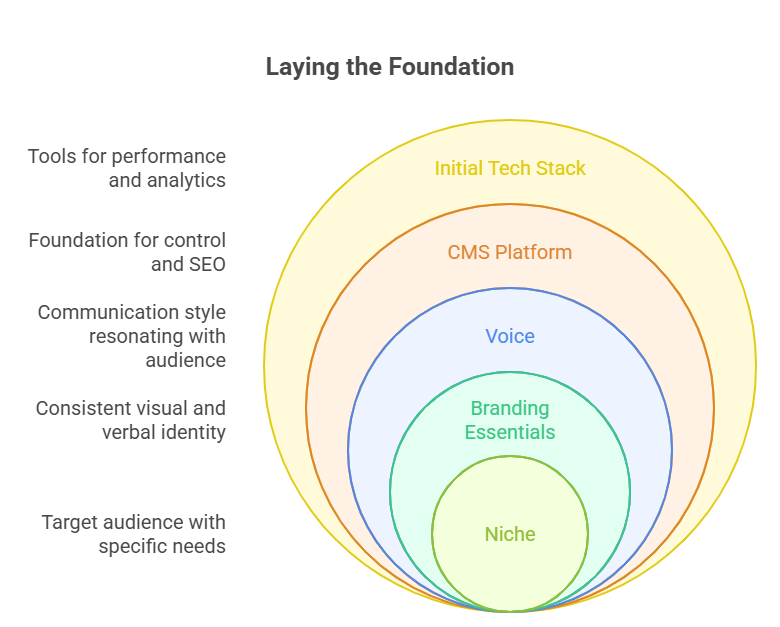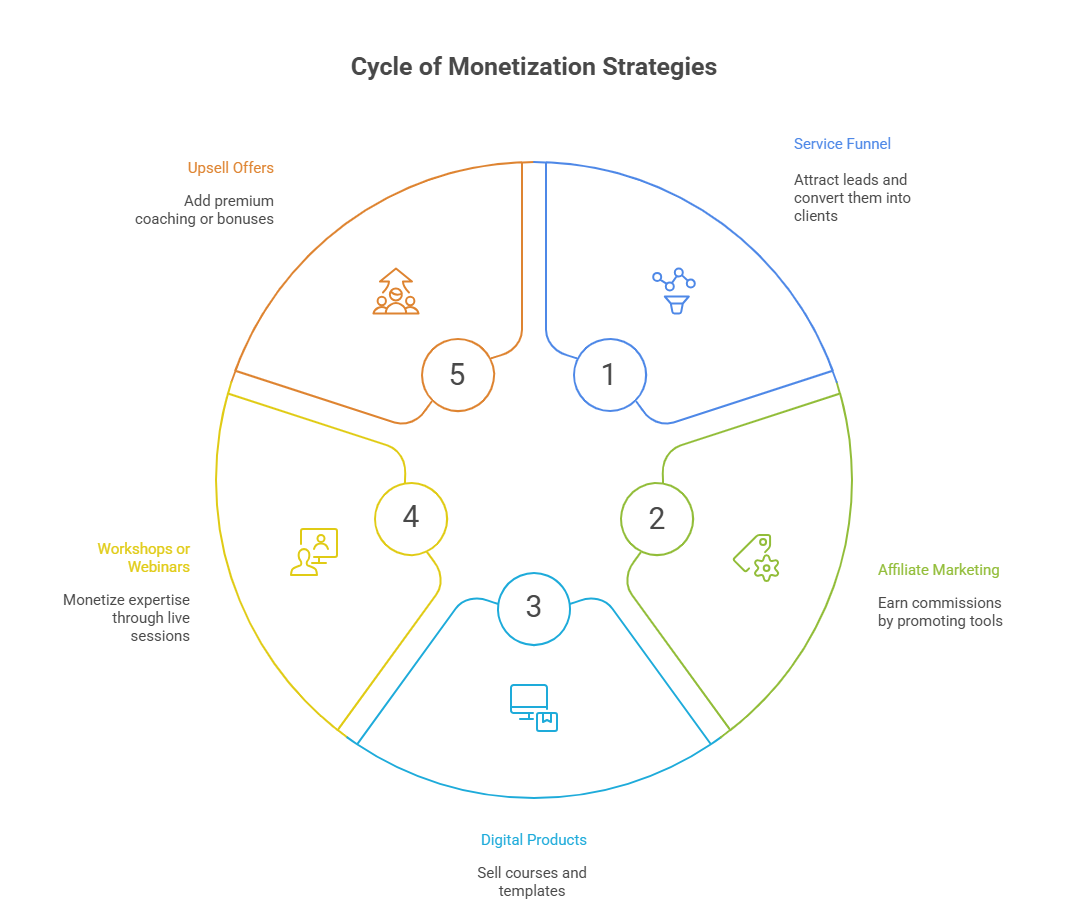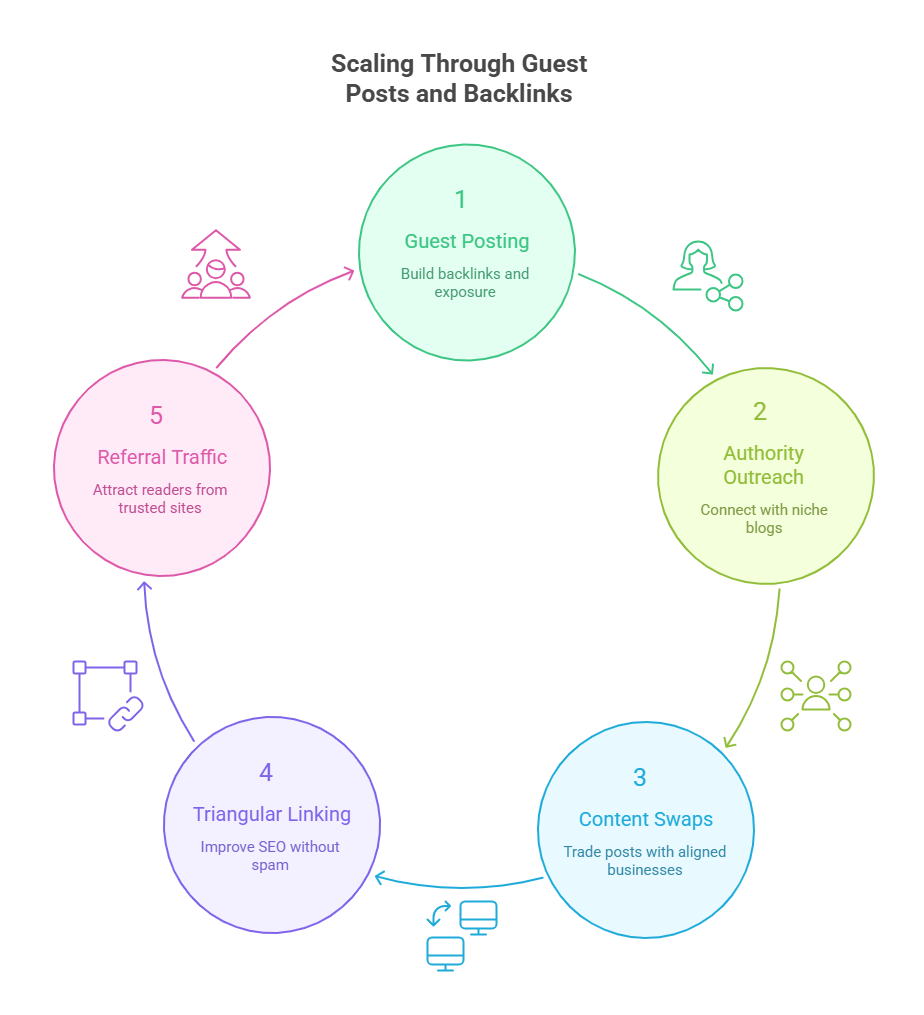Building and Monetizing Your Coaching Blog
A blog isn’t just a place to share your thoughts. In 2025, your blog is your business engine. It’s the storefront, the marketing funnel, and the passive income stream that works while you sleep. If you’re a coach who isn’t leveraging a blog, you’re missing out on leads, sales, and authority. More importantly, you're handing over those opportunities to competitors who are simply more visible.
In this guide, you will learn how to launch and scale a coaching blog that drives leads and cash flow. You’ll see exactly what systems to set up, how to create content that ranks and converts, and how to build an ecosystem that scales with you—whether you're offering high-ticket coaching, digital products, or affiliate tools. You don’t need to be tech-savvy or a marketing pro. You need clarity, strategy, and consistency. Let’s unpack how you can turn your expertise into a blog that works for you—day in, day out.
Laying the Foundation
Choosing a Profitable Niche
Don’t write about everything. Write for someone. A profitable coaching blog starts with a narrow, high-demand coaching niche—one that intersects your expertise with what people are actively searching for and willing to pay for.
Think in terms of problems, not passions. For example, “life coaching for moms returning to work” is sharper than just “life coaching.” The more specific your niche, the easier it becomes to rank, convert, and retain.
Validate your niche using:
Google Keyword Planner to check monthly search volumes
Tools like AnswerThePublic to find what people are asking
Communities like Reddit, Quora, and Facebook Groups to spot trending pain points
And finally, ask yourself: Would someone pay for a solution in this space? If not, keep narrowing or adjusting.
Setting Up the Right CMS (e.g., WordPress)
You need control, scalability, and SEO power. WordPress powers over 43% of the web for good reason. It’s open-source, flexible, and integrates seamlessly with SEO plugins, email tools, and course platforms.
Set your blog up on:
WordPress.org (not WordPress.com) for full ownership
A lightweight, mobile-optimized theme like Astra or Kadence
Plugins like Rank Math or Yoast SEO for optimization
Speed boosters like WP Rocket and image compressors
Avoid DIY website builders like Wix or Squarespace if long-term growth and SEO are priorities.
Branding and Voice Consistency
Branding isn’t just your logo. It’s the emotional signature of your blog. Coaches thrive on connection, and your voice needs to reflect who you are—warm, confident, and clear.
Lock in your:
Visual identity: colors, fonts, spacing
Tone of voice: Are you authoritative? Empathetic? Straight-talking?
Formatting rules: bullet usage, paragraph length, CTA phrasing
Your brand should feel familiar across every blog post, email, and lead magnet. Consistency builds trust, recognition, and conversion.
Content Strategy That Attracts
SEO-Driven Blog Topics
You’re not just writing to share—you’re writing to rank and convert. The right blog topics should be rooted in high-intent keywords that your audience is already searching for. Start with bottom-funnel queries like:
“Best productivity tools for coaches”
“How to price coaching sessions”
“Business plan for life coaches”
Use tools like Ahrefs, Ubersuggest, or Semrush to find keywords with decent search volume and low competition. Then, group them by search intent:
Informational: for education (e.g., “What is mindset coaching?”)
Transactional: for conversions (e.g., “Best course platform for coaches”)
Comparative: for affiliate income (e.g., “Kajabi vs Teachable for coaching”)
Every post should be optimized with:
Keyword in URL, H1, intro, and conclusion
At least one internal link to your service or lead magnet
A powerful CTA matched to the reader’s stage
Consistency and Topic Clustering
Google rewards topical authority. That means you can’t just write once and disappear. You need a cluster of posts around each core topic, all interlinked to show expertise.
Example: If your niche is career coaching for Gen Z, your topic cluster might include:
“How to build a resume with no experience”
“Best job boards for Gen Z”
“Networking tips for new graduates”
“How to choose between two job offers”
Each cluster has one pillar page and multiple supporting posts. Interlink them naturally to help both SEO and user navigation. This structure keeps readers on-site longer and signals depth to search engines.
Creating a Monthly Editorial Calendar
A content calendar is your consistency engine. Without it, you’ll fall into the trap of random posting and burnout. Build a 12-month calendar around:
Core themes (based on topic clusters)
Keyword goals
Campaigns (e.g., product launches, webinar promos)
Each month, schedule:
2–4 SEO blogs
1–2 conversion blogs (testimonials, case studies)
1 repurposed piece (from podcast, YouTube, or webinar)
Use tools like Notion, Trello, or even a shared Google Sheet to plan post dates, titles, keywords, and CTAs. Stick to the schedule even when traffic feels slow. Momentum compounds visibility and lead flow.
| Content Type | Purpose | Details |
|---|---|---|
| SEO Blog Posts | Attract organic traffic from search engines | Target specific keywords with high intent, optimize metadata, and structure content using H2s, internal links, and CTA placement |
| Topic Clusters | Build topical authority and site structure | Create a pillar post supported by related articles interlinked around the same subject (e.g., productivity coaching) |
| Lead Magnet Blogs | Grow your email list through content | Offer free downloads (checklists, guides) embedded in posts to capture emails from readers solving a problem |
| Conversion-Focused Posts | Convert readers into clients or buyers | Use storytelling, testimonials, and benefit-focused copy to lead into a coaching call or product sale |
| Monthly Editorial Calendar | Ensure strategic and consistent publishing | Plan 4–6 content pieces monthly with assigned keywords, CTAs, and product tie-ins; use tools like Notion or Google Sheets |
Monetization Models for Coaching Blogs
Selling Services Through Blog Funnels
Your blog should be your #1 sales funnel, not just a traffic generator. Each post should lead readers to one clear next step—booking a discovery call, joining your email list, or buying a session.
Here’s how to funnel readers:
Use lead magnets inside informational posts (e.g., “free session worksheet”)
Insert service CTAs in high-intent posts (e.g., “Work with me” for readers on pricing guides)
Build trust with case studies and transformation stories
Structure your funnel like this:
Top-of-funnel blog post (e.g., “How to stop procrastinating”)
Mid-funnel lead magnet (free checklist)
Bottom-funnel nurture email series
Service pitch with social proof
Done right, this turns your blog into a 24/7 client acquisition engine.
Affiliate Marketing & Tools You Use
You’re already using tools to run your business—why not get paid to recommend them? Add affiliate links to tools you genuinely use and trust: course platforms, email services, webinar tools, books.
Best practices:
Write comparison and review posts (these convert highest)
Include disclaimers and only promote tools that align with your brand
Use Pretty Links or similar plugins to cloak and track URLs
High-ROI blog ideas:
“Best course platforms for mindset coaches”
“Tools I use to run my coaching business”
“Kajabi vs Teachable for digital coaching products”
Even with modest traffic, affiliate links can drive recurring passive income.
Digital Products (Courses, eBooks)
This is where you shift from 1:1 time to one-to-many revenue. Turn your most requested frameworks, tools, or processes into:
Mini courses
Email series
Templates and swipe files
eBooks or toolkits
Use your blog to validate product demand. If a post consistently ranks and gets email sign-ups, it’s a signal to create a paid product around it.
Pair each product with:
A content series (SEO + nurture)
A low-ticket sales funnel ($27–$97)
Bonuses to increase perceived value
With the right digital product stack, your blog becomes a product launchpad, not just a journal.
Scaling Through Guest Posts and Backlinks
Outreach Strategy for Authority Sites
You don’t scale visibility by blogging in isolation. You scale by getting your content on authority sites—blogs, magazines, and directories your audience already trusts. Guest posts get you in front of new readers, build your SEO, and establish you as an expert.
To land guest posts:
Identify 30+ blogs in your niche (coaching, personal development, entrepreneurship)
Use Hunter.io or LinkedIn to find content editors or site managers
Pitch specific, keyword-rich topics that align with their audience
Showcase your blog or samples as proof of quality
When accepted, include a contextual backlink to a key blog post or landing page—not just your homepage. This tells Google you’re relevant, boosts your domain authority, and sends referral traffic.
Link Exchanges & Content Swaps
Strategic link exchanges (done right) can skyrocket your rankings. Find other coaches or service providers with blogs of similar authority and offer a value-aligned swap.
Best practices:
Avoid “link for link” trades on the same day—Google flags this
Instead, do triangular exchanges or space them out
Keep links contextual and relevant to the surrounding text
Aim for inclusion within valuable blog content, not footers or sidebar dumps
Another approach: content swaps. You write for their blog, they write for yours. This builds fresh content, shares backlinks, and cross-pollinates your audiences.
Metrics & Optimization
Google Analytics and Search Console
If you’re not measuring, you’re guessing. Google Analytics and Search Console are non-negotiables if you want your coaching blog to actually grow. They show you what’s working, what’s failing, and where to double down.
Track key blog metrics like:
Organic traffic by landing page (what’s ranking?)
Time on page and bounce rate (is your content engaging?)
Conversion events (email sign-ups, button clicks)
In Search Console, monitor:
Top search queries bringing clicks
Pages with high impressions but low CTR (update titles/meta descriptions)
Indexing errors or crawl issues affecting visibility
Use this data to inform your next blog topics, update underperforming posts, and refine your funnel flow. Don’t blog blind—let the data guide you.
A/B Testing CTAs and Lead Magnets
A simple tweak in your CTA wording or placement could double conversions. That’s where A/B testing comes in. You’re not just optimizing for clicks—you’re optimizing for action.
Test:
Button colors and CTA copy (e.g., “Start Free” vs “Book Now”)
Placement (top, mid-content, end-of-post)
Lead magnet formats (PDF guide vs mini course)
Tools like ConvertBox, Thrive Leads, or even Google Optimize can run these tests seamlessly. Set a test to run until at least 1,000 visitors per variation to get statistically reliable results.
The goal? Incremental gains that compound. If every post gets even 0.5% better at converting, that’s a scalable edge.
| Metric/Tool | What to Track | Details |
|---|---|---|
| Google Analytics | Visitor behavior and site performance | Monitor sessions, bounce rate, time on page, and user paths to understand which posts perform best and where users drop off |
| Search Console | Keyword rankings and indexing issues | Track which queries drive impressions and clicks, analyze click-through rate (CTR), and identify crawl or indexing errors |
| Bounce Rate | User engagement and content relevance | A high bounce rate indicates the content doesn’t match user expectations; optimize with better intros, CTAs, and internal links |
| CTA Conversion Rate | Effectiveness of calls to action | Measure how many users click or submit lead forms; test different placements and wording to boost conversion rates |
| A/B Testing Tools | Optimization of blog layout and elements | Use tools like Google Optimize or ConvertBox to test headlines, buttons, or lead magnet formats and improve performance over time |
Launch Your Coaching Blog with the Health and Life Coaching Certification
Launch Framework + SEO Setup
If you’re certified through the Health and Life Coaching Certification by ANHCO, you already have the expertise—now it's time to build the visibility that matches it. Our Done-For-You Blog Builder is designed specifically for certified coaches who want to skip the tech overwhelm and get straight to monetization.
Here’s what we set up for you:
A WordPress site optimized for SEO from Day 1
Pre-written pillar blogs based on high-intent keywords
Technical setup: Google Analytics, Search Console, and schema markup
A lead capture system integrated with your email platform
We don’t just hand you a blog—we hand you a conversion-ready content engine that’s mapped to your niche, voice, and coaching focus.
Templates to Monetize Faster
Most coaches get stuck trying to figure out what to write or how to “sell” without being pushy. We solve that with plug-and-play templates you can customize within minutes.
You get:
SEO blog outlines mapped to search intent
CTA swipe files for free sessions, lead magnets, and product promos
Templates for service pages, About sections, and digital offers
A content calendar aligned with launch windows and seasonal trends
With your Health and Life Coaching Certification as the core, these assets fast-track your ability to turn readers into clients, subscribers, and buyers.
Frequently Asked Questions
-
Aim for at least 2 high-quality blog posts per month, especially if you’re just starting out. What matters more than quantity is consistency and strategic keyword alignment. Posting once every week is ideal if you have the capacity, but don’t sacrifice quality to meet arbitrary frequency goals. Make sure each post targets a relevant search query, solves a specific pain point for your audience, and contains a clear next step or CTA. Over time, a smaller number of well-optimized posts will outperform dozens of scattered, low-quality ones.
-
Absolutely. Monetization doesn’t require thousands of followers—it requires focused, high-intent content. A well-written blog targeting the right keywords can attract potential clients through organic search. From there, you can monetize using affiliate links, digital products, and lead magnets that lead to 1:1 services. Even a blog with a few hundred monthly readers can drive coaching calls and product sales if it targets a well-defined niche and solves real problems.
-
WordPress.org is the most powerful and scalable option for serious coaching blogs. It offers full control over design, SEO structure, and monetization. Paired with a fast theme (like Astra or Kadence) and plugins like Rank Math or Yoast, you’ll have everything needed to rank well and convert readers. Avoid all-in-one page builders unless blogging is a secondary priority. WordPress gives you the tools to grow from solo coach to content-driven business owner.
-
It’s not enough to educate—you must guide readers toward the next step. Add strong calls-to-action (CTAs) throughout your content. These could be lead magnets (e.g., free checklist), discovery calls, or product links. Use action verbs like “Download,” “Start,” “Get,” or “Book.” Place CTAs in 3 key areas: early in the content, in the middle after a major value drop, and at the end. Make them visually distinct and relevant to the post’s topic for maximum engagement.
-
The highest-performing posts often fall into three buckets:
Solution-focused how-tos (e.g., “How to Set Boundaries in Relationships”)
List-style resources (e.g., “10 Mindset Shifts for Burned-Out Entrepreneurs”)
Comparisons and reviews (e.g., “Best Journaling Tools for Health Coaches”)
Each of these builds authority while solving real-world problems. Use storytelling, data, and transformation examples to make your content relatable and actionable. Make sure to link internally to your services or lead magnets to keep readers moving deeper into your funnel.
-
Blog posts should be 1,200–2,000 words, depending on the keyword and topic depth. Shorter posts (~800 words) may work for listicles or roundups, but long-form content tends to rank better and build trust faster. If your post answers a high-value question or covers a complex transformation, don’t be afraid to go beyond 2,500 words—just make sure it stays structured, scannable, and free of fluff. Use subheaders, bullet points, and spacing to improve readability.
-
Niching down wins—every time. Google rewards topical depth, and readers want specific solutions, not general advice. Instead of “life coaching,” go after a defined niche like “confidence coaching for introverted professionals” or “health coaching for busy moms over 40.” Your blog topics should reflect that niche, building authority in a single domain. Over time, this focused approach will help your site rank faster, convert higher, and stand out clearly in a crowded space.
Final Thoughts
Your blog isn’t just content—it’s your business growth system. When built strategically, it brings you clients, builds trust, and becomes a scalable income stream. But strategy matters. From choosing a tight niche to optimizing for keywords and conversion, every post should work toward a business goal.
Whether you’re promoting your Health and Life Coaching Certification, selling digital products, or booking high-ticket clients, your blog is the bridge. The coaches who win in 2025 are the ones who treat their blog like a growth asset, not a side hobby.
What’s your biggest challenge with building your coaching blog?




